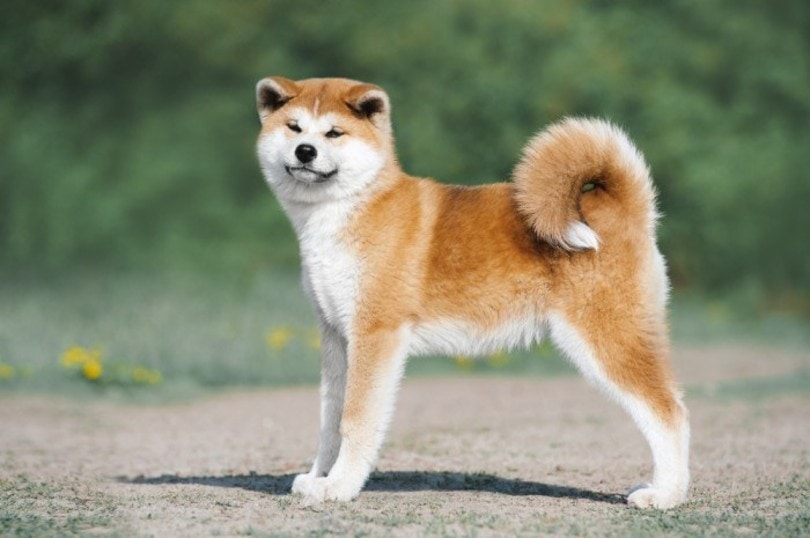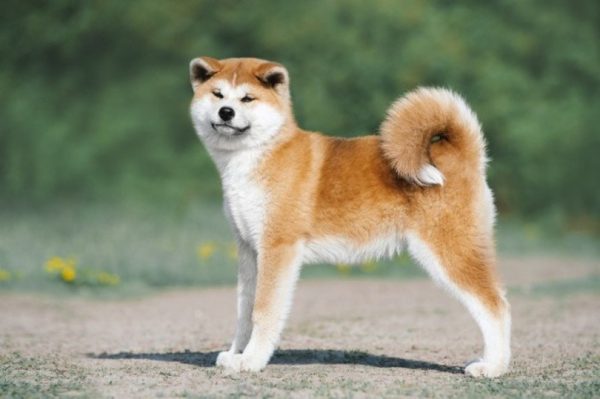Known for their impressive size and dignified presence, Akitas have captivated dog enthusiasts for centuries. But what if we told you that there are other breeds out there that share these majestic qualities? From the striking and imposing Alaskan Malamute to the elegant and graceful Shiba Inu, these remarkable canines will leave you in awe. So, if you’re in search of a loyal and protective companion or simply want to admire the beauty of these magnificent creatures, here are 6 extraordinary dog breeds that bear a striking resemblance to the regal and awe-inspiring Akita.
Characteristics of Akita Dogs
| Average Lifespan: | 10 – 12 years |
| Average Weight: | 51 – 86 pounds |
Before we dive into the world of Akita-like dog breeds, let’s take a closer look at the characteristics that make Akitas so special. Akitas are a large, powerful, and super intelligent breed that originated in Japan. They’re known for their strong loyalty and protective nature, making them excellent guard dogs and family companions. Akitas have a robust build, with a broad head, erect ears, and a curled tail that rests on their back. Their thick double coat comes in various colors, including white, brindle, and pinto. These dogs are easy to train and love protecting their owners.
But, one of the most distinctive features of Akitas is their expressive eyes. They have small, deep-set eyes that give them an intense and alert look. Akitas are smart and independent dogs, which can sometimes make training a challenge. However, with proper socialization and consistent training, they can become well-behaved and obedient companions. Akitas are also known for their strong prey drive and may not be suitable for households with small pets.
Dog Breeds Similar to the Akita
1. Shiba Inu
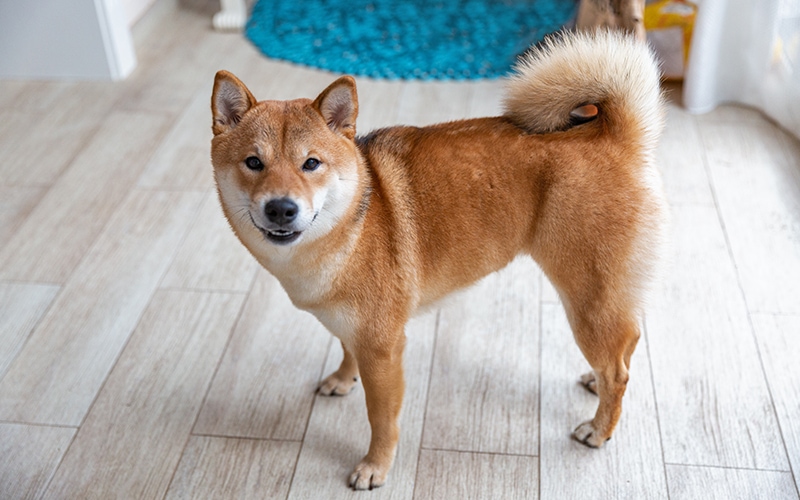
| Average Lifespan: | 13 – 16 years |
| Average Weight: | 17 – 23 pounds |
If you’re looking for a breed that resembles the Akita but just in a smaller package, the Shiba Inu might be the perfect choice for you. Originating from Japan, the Shiba Inu is a small to medium-sized breed known for its fox-like appearance and spirited personality. Despite their compact size, Shiba Inus possess a strong and sturdy build. They have a thick double coat that comes in various colors, including red, black and tan, and cream. With their erect ears and curled tail, Shiba Inus have a striking resemblance to their larger Akita cousins.
Shiba Inus are known for their independent and confident nature. They’re intelligent dogs but can be stubborn at times, making consistent training essential. Despite their independence, Shiba Inus are loyal and affectionate with their families. They’re not overly demanding in terms of exercise and can adapt well to different living environments. However, it’s important to note that Shiba Inus have a strong prey drive and may not get along well with small animals. If you’re looking for a compact and active companion that resembles the majestic Akita, the Shiba Inu is a breed worth considering.
2. Chow Chow

| Average Lifespan: | 9 – 15 years |
| Average Weight: | 50 – 75 pounds |
If you’re captivated by the majestic appearance of Akitas and want a dog that almost resembles a bear, look no further than the Chow Chow. The Chow Chow came from China and is a medium to large-sized breed known for its distinctive lion-like mane and fluffy bear-like appearance. Chow Chows have a really sturdy build with a broad head, deep-set eyes, and a thick double coat that comes in various colors, including red, black, blue, and cream.
They’re loyal and protective of their families, making them excellent guard dogs. Despite their imposing appearance, Chow Chows can be affectionate and gentle with their loved ones. However, they can be reserved and aloof with strangers, requiring early socialization to ensure proper behavior. Chow Chows have a moderate exercise requirement and can adapt well to apartment living.
3. Alaskan Malamute
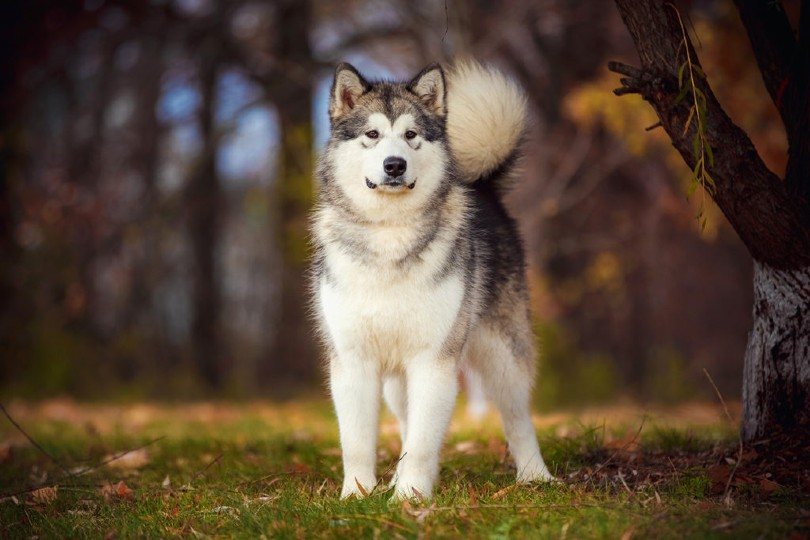
| Average Lifespan: | 10 – 12 years |
| Average Weight: | 50 – 75 pounds |
The Alaskan Malamute is a breed that’s known as the original sled dog. They’re powerful, large and are known for their incredible strength and endurance. With their intimidating size, webbed feet, thick coat and robust build, Alaskan Malamutes are often still used as sled dogs in cold climates. They have a dense double coat that provides insulation against the harsh weather, and their coat colors can range from various shades of gray to black and white.
Alaskan Malamutes are quite friendly and affectionate dogs that thrive in a family environment. They have a rather playful nature and a love for outdoor activities. However, it’s important to note that Alaskan Malamutes also have a strong prey drive and may not get along well with other household pets. These dogs will definitely need to be trained when they’re young to prevent them from becoming quite dangerous as adults.
4. American Eskimo Dog
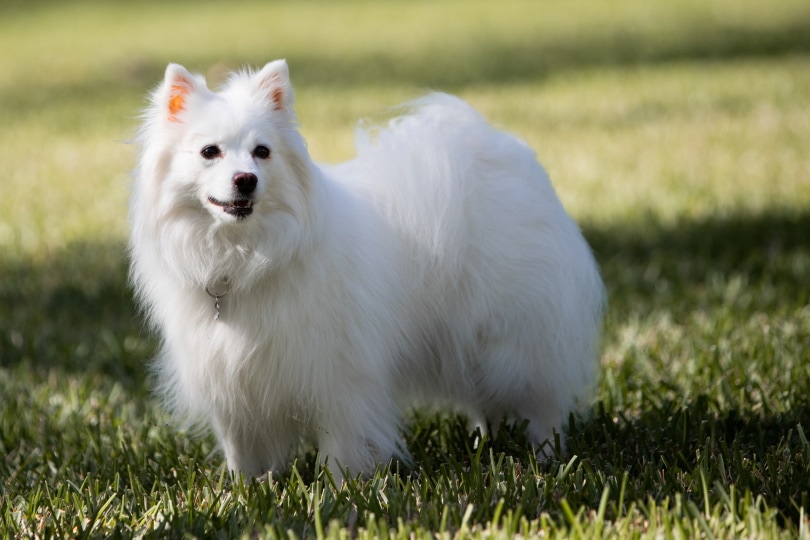
| Average Lifespan: | 13 – 15 years |
| Average Weight: | 12 – 16 pounds |
If you’re captivated by the beautiful white coat of Akitas and want a breed that also shares this feature, the American Eskimo Dog might be the perfect choice for you. Despite its name, the American Eskimo Dog isn’t from Alaska but is believed to have actually originated from Germany. This medium-sized breed is known for its stunning white coat, bushy tail (like the Akitas), and erect ears. American Eskimo Dogs actually come in three sizes – toy, miniature, and standard, but all share the same enchanting appearance.
These dogs are super-smart and happy dogs that absolutely love human interaction. They have a friendly and outgoing nature, making them excellent family pets. But despite their fluffy appearance, American Eskimo Dogs are relatively low maintenance when it comes to grooming. They do, however, require regular exercise to keep them healthy and from being destructive.
5. Finnish Spitz
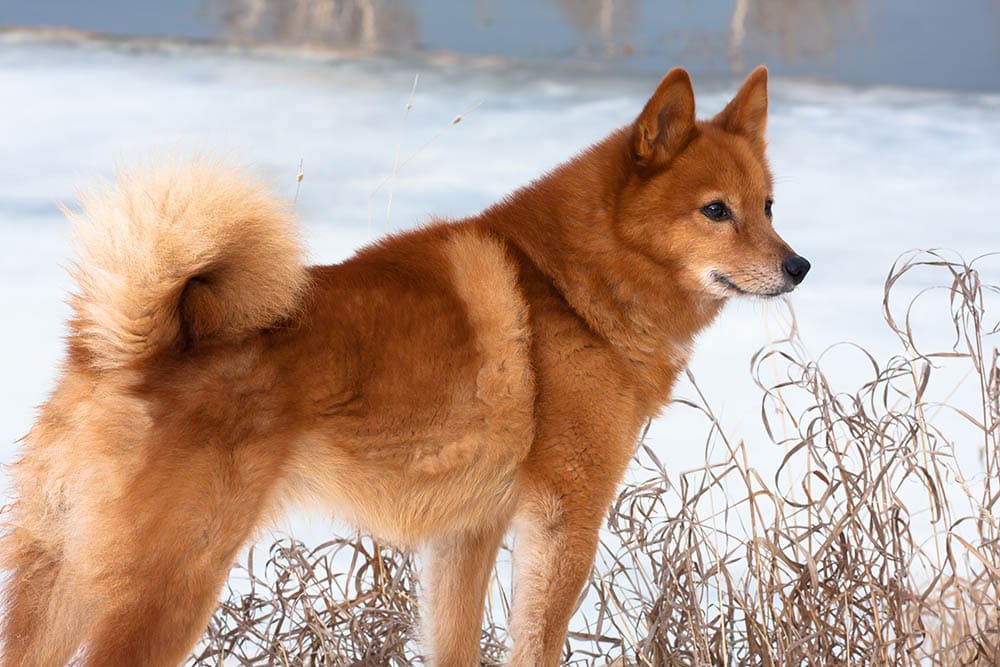
| Average Lifespan: | 12 – 15 years |
| Average Weight: | 30 – 35 pounds |
If you’re captivated by the fox-like appearance of Akitas and want a breed with similar qualities, the Finnish Spitz might be worth taking a look at. The Finnish Spitz did, in fact, originate in Finland as is a medium-sized breed known for its striking red coat. This breed, like Akitas, has a fox-like face and erect ears, and a fluffy coat (though not as fluffy as the Akita). This breed has been used as a hunting dog for centuries, known for its exceptional ability to locate and bark at game birds to alert hunters.
Finnish Spitz dogs, like Akitas, are intelligent and independent thinkers. They’re known for their alert and vocal nature, making them excellent watchdogs. Despite their hunting background, Finnish Spitz dogs can adapt well to family life and are generally good with children and other pets when properly socialized. They have a moderate exercise requirement and enjoy outdoor activities.
6. Tosa Inu

| Average Lifespan: | 10 – 12 years |
| Average Weight: | 120 – 170 pounds |
If you’re drawn to the protective nature of Akitas and want a breed that shares this trait, the Tosa Inu is a good choice. Though these dogs don’t share a similar appearance or lineage with Akitas, they do have a rather huge muzzle and are just as powerful. The Tosa Inu is a large and powerful breed known for its imposing size and protective instincts. They have a short, dense coat that’s commonly seen in brindle, rust, black, and white.
Tosa Inus are known for their loyalty and protective nature. They’re often used as guard dogs in Japan and require firm and consistent training from an early age. Despite their protective instincts, Tosa Inus can be affectionate and gentle with their families. However, it’s important to note that they may not get along well with unfamiliar dogs and should be properly socialized – especially if you plan to take them out to places like dog parks and beaches.
Tosa Inus, due to their large size and exercise requirements, will need to spend at least 30 to 45 minutes a day taking in some type of activity. Otherwise, you may find an agitated or destructive dog on your hands. But, if you’re looking for a massive and protective breed that resembles the Akita in temperament rather than looks, the Tosa Inu is a good runner up.
A Quick Bit on the Origins of the Akita Breed
Originally known as the Akita Inu, these dogs were developed in the Akita region of northern Japan. They were initially bred for hunting large game, such as bears and boars. However, their role soon expanded to include guarding, herding, and even serving as loyal companions to Japanese royalty. Today, Akitas are still highly regarded in Japan and have gained popularity worldwide. Their unique history and cultural significance make them a very memorable and distinguished breed.
Akita Breed Variations and Colors
Akitas are a breed of dog with a unique appearance that sets them apart from other breeds. However, there are differences within the breed itself. The two main variations of Akitas are the American Akita and the Japanese Akita. While both variations share similar physical characteristics and temperament, there are slight variations between them.
The American Akita is generally larger and more robust than the Japanese Akita. They have a broader head and a more substantial bone structure, giving them a powerful and imposing appearance.
Another difference between the two variations is the range of colors that American Akitas come in. They can be found in a wider range of colors such as brindle, black, and white. On the other hand, Japanese Akitas are predominantly found in red, fawn, or sesame coloration. Despite these differences, both variations of Akitas share similar traits such as loyalty, intelligence, and a strong protective instinct towards their owners.
When considering adopting an Akita, it’s essential to research both variations to determine which one fits your lifestyle and personality best. Both variations require training, socialization, and regular exercise to keep them healthy and non-destructive.
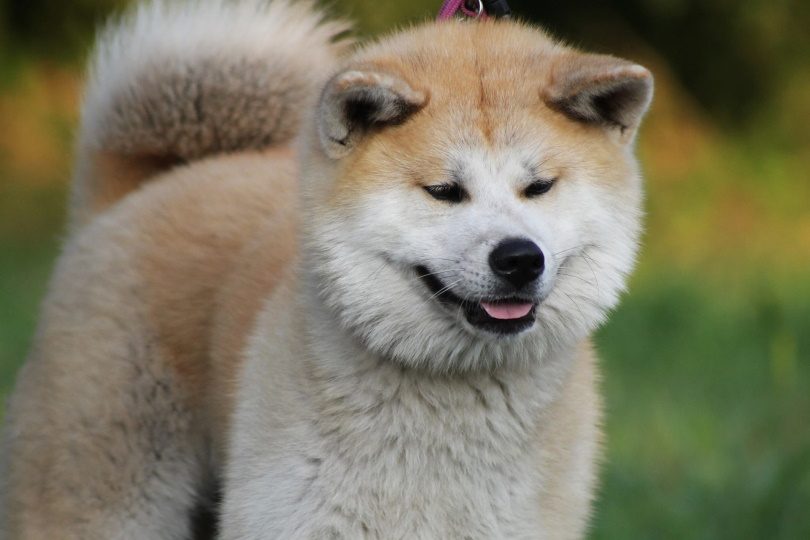
Common FAQs About Akitas
Should I shave my Akita in the summer?
As a general rule, it’s not recommended to shave an Akita, or any double-coated breed for that matter. The double coat acts as a layer of insulation and keeps them warm in the winter and cool in the summer. Shaving the coat can lead to sunburn, overheating, and even skin problems. Instead, regular brushing and grooming can help keep your Akita’s coat healthy and comfortable during the warmer months. Additionally, providing access to shade and plenty of fresh water will help keep your pet cool and comfortable during hot weather.
Does the Akita make a good companion dog?
Whether or not the Akita makes a good companion dog depends on a variety of factors. For example, the temperament of the individual Akita must be taken into consideration. Some Akitas can be aggressive or aloof towards strangers, which can make them difficult to handle as a companion dog – but early socialization can help with this. Keep in mind these dogs also need a lot of exercise and playtime daily. And without enough exercise and stimulation, they can become bored and destructive.
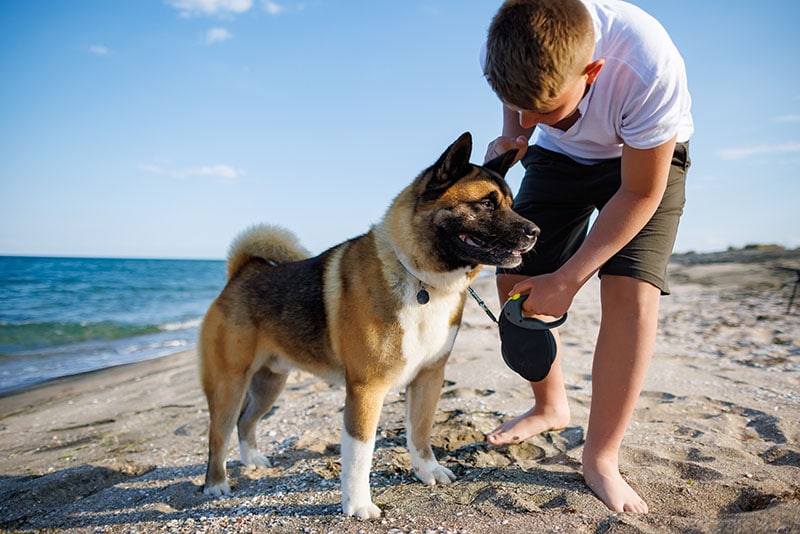
Does the Akita swim well?
The Akita isn’t known for being a breed that excels at swimming – they tend to do better on land or in the snow. In fact, due to their heavy build and thick coat, many Akitas may struggle in the water. While some Akitas may enjoy swimming and be able to do so with ease, it’s important for owners to monitor their dog’s behavior and comfort level in the water. But they can definitely learn to swim. It’s recommended to introduce an Akita to water gradually and with plenty of positive reinforcement. It’s also best to start these dogs in the water as young pups to get them used to dog paddling – bathtubs and outdoor pools are great places to start training your young Akita pup to swim.
Summing Up
If you’re in search of a unique and majestic companion that resembles the regal Akita, there are several extraordinary dog breeds to consider. Whether you’re captivated by their imposing size, gorgeous appearance, or protective instincts, there is a breed out there that will work for you and your family. So, take your time, do your research and find the perfect Akita-ish dog breed that suits your lifestyle and preferences.
Featured Image Credit: Anaite, Shutterstock

